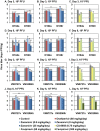Characterization of oseltamivir-resistant 2009 H1N1 pandemic influenza A viruses
- PMID: 20865125
- PMCID: PMC2928817
- DOI: 10.1371/journal.ppat.1001079
Characterization of oseltamivir-resistant 2009 H1N1 pandemic influenza A viruses
Abstract
Influenza viruses resistant to antiviral drugs emerge frequently. Not surprisingly, the widespread treatment in many countries of patients infected with 2009 pandemic influenza A (H1N1) viruses with the neuraminidase (NA) inhibitors oseltamivir and zanamivir has led to the emergence of pandemic strains resistant to these drugs. Sporadic cases of pandemic influenza have been associated with mutant viruses possessing a histidine-to-tyrosine substitution at position 274 (H274Y) in the NA, a mutation known to be responsible for oseltamivir resistance. Here, we characterized in vitro and in vivo properties of two pairs of oseltaimivir-sensitive and -resistant (possessing the NA H274Y substitution) 2009 H1N1 pandemic viruses isolated in different parts of the world. An in vitro NA inhibition assay confirmed that the NA H274Y substitution confers oseltamivir resistance to 2009 H1N1 pandemic viruses. In mouse lungs, we found no significant difference in replication between oseltamivir-sensitive and -resistant viruses. In the lungs of mice treated with oseltamivir or even zanamivir, 2009 H1N1 pandemic viruses with the NA H274Y substitution replicated efficiently. Pathological analysis revealed that the pathogenicities of the oseltamivir-resistant viruses were comparable to those of their oseltamivir-sensitive counterparts in ferrets. Further, the oseltamivir-resistant viruses transmitted between ferrets as efficiently as their oseltamivir-sensitive counterparts. Collectively, these data indicate that oseltamivir-resistant 2009 H1N1 pandemic viruses with the NA H274Y substitution were comparable to their oseltamivir-sensitive counterparts in their pathogenicity and transmissibility in animal models. Our findings highlight the possibility that NA H274Y-possessing oseltamivir-resistant 2009 H1N1 pandemic viruses could supersede oseltamivir-sensitive viruses, as occurred with seasonal H1N1 viruses.
Conflict of interest statement
Dr. Kawaoka has received speaker's honoraria from Chugai Pharmaceuticals, Novartis, Daiichi-Sankyo, Toyama Chemical, Wyeth, and GlaxoSmithKline; grant support from Chugai Pharmaceuticals, Daiichi Sankyo, and Toyama Chemical; is a consultant for Theraclone and Crucell; and is a founder of FluGen.
Figures


Similar articles
-
Effect of an asparagine-to-serine mutation at position 294 in neuraminidase on the pathogenicity of highly pathogenic H5N1 influenza A virus.J Virol. 2011 May;85(10):4667-72. doi: 10.1128/JVI.00047-11. Epub 2011 Mar 2. J Virol. 2011. PMID: 21367898 Free PMC article.
-
Effect of the neuraminidase mutation H274Y conferring resistance to oseltamivir on the replicative capacity and virulence of old and recent human influenza A(H1N1) viruses.J Infect Dis. 2010 Mar;201(5):740-5. doi: 10.1086/650464. J Infect Dis. 2010. PMID: 20100088
-
Comparable fitness and transmissibility between oseltamivir-resistant pandemic 2009 and seasonal H1N1 influenza viruses with the H275Y neuraminidase mutation.J Virol. 2012 Oct;86(19):10558-70. doi: 10.1128/JVI.00985-12. Epub 2012 Jul 18. J Virol. 2012. PMID: 22811535 Free PMC article.
-
Emerging oseltamivir resistance in seasonal and pandemic influenza A/H1N1.J Clin Virol. 2011 Oct;52(2):70-8. doi: 10.1016/j.jcv.2011.05.019. Epub 2011 Jun 17. J Clin Virol. 2011. PMID: 21684202 Review.
-
Consequences of resistance: in vitro fitness, in vivo infectivity, and transmissibility of oseltamivir-resistant influenza A viruses.Influenza Other Respir Viruses. 2013 Jan;7 Suppl 1(Suppl 1):50-7. doi: 10.1111/irv.12044. Influenza Other Respir Viruses. 2013. PMID: 23279897 Free PMC article. Review.
Cited by
-
A Novel Endonuclease Inhibitor Exhibits Broad-Spectrum Anti-Influenza Virus Activity In Vitro.Antimicrob Agents Chemother. 2016 Aug 22;60(9):5504-14. doi: 10.1128/AAC.00888-16. Print 2016 Sep. Antimicrob Agents Chemother. 2016. PMID: 27381402 Free PMC article.
-
Monitoring and characterization of oseltamivir-resistant pandemic (H1N1) 2009 virus, Japan, 2009-2010.Emerg Infect Dis. 2011 Mar;17(3):470-9. doi: 10.3201/eid1703.101188. Emerg Infect Dis. 2011. PMID: 21392439 Free PMC article.
-
Estimating the fitness advantage conferred by permissive neuraminidase mutations in recent oseltamivir-resistant A(H1N1)pdm09 influenza viruses.PLoS Pathog. 2014 Apr 3;10(4):e1004065. doi: 10.1371/journal.ppat.1004065. eCollection 2014 Apr. PLoS Pathog. 2014. PMID: 24699865 Free PMC article.
-
Profiling and characterization of influenza virus N1 strains potentially resistant to multiple neuraminidase inhibitors.J Virol. 2015 Jan;89(1):287-99. doi: 10.1128/JVI.02485-14. Epub 2014 Oct 15. J Virol. 2015. PMID: 25320319 Free PMC article.
-
Environmental levels of the antiviral oseltamivir induce development of resistance mutation H274Y in influenza A/H1N1 virus in mallards.PLoS One. 2011;6(9):e24742. doi: 10.1371/journal.pone.0024742. Epub 2011 Sep 12. PLoS One. 2011. PMID: 21931841 Free PMC article.
References
-
- Dawood FS, Jain S, Finelli L, Shaw MW, Lindstrom S, et al. Emergence of a novel swine-origin influenza A (H1N1) virus in humans. N Engl J Med. 2009;360:2605–2615. - PubMed
-
- Jain S, Kamimoto L, Bramley AM, Schmitz AM, Benoit SR, et al. Hospitalized patients with 2009 H1N1 influenza in the United States, April-June 2009. N Engl J Med. 2009;361:1935–1944. - PubMed
Publication types
MeSH terms
Substances
Grants and funding
LinkOut - more resources
Full Text Sources
Other Literature Sources

